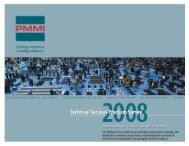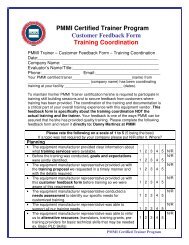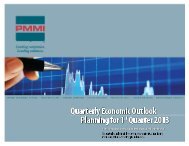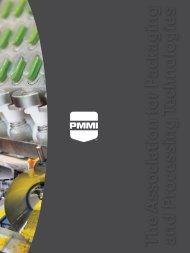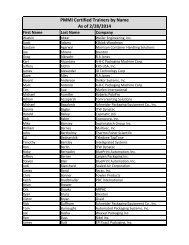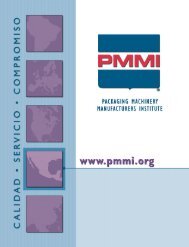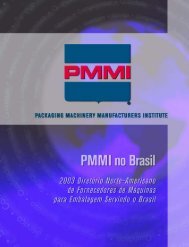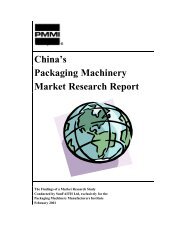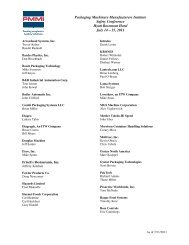Germany Packaging Machinery Market Research Report - PMMI
Germany Packaging Machinery Market Research Report - PMMI
Germany Packaging Machinery Market Research Report - PMMI
Create successful ePaper yourself
Turn your PDF publications into a flip-book with our unique Google optimized e-Paper software.
1. 80<br />
2. EXECUTIVE SUMMARY<br />
2.1 THE GERMAN MARKET FOR PACKAGING MACHINERY<br />
The most important industry sectors using packaging machinery are food, beverages, and chemicals<br />
(including pharmaceuticals, personal care, detergents, and paints). In these sectors, an increasing<br />
demand for both packaging and packaging machinery is expected, especially in:<br />
a) the beverage industry due to stricter regulations about recycling and environmental issues in<br />
general;<br />
b) the cosmetic industry due to the increasing significance of packaging as a marketing tool;<br />
c) the food industry due to a strong trend toward convenience food and smaller packaging sizes.<br />
The German market for packaging machinery is dominated by German suppliers. Bosch, Klöckner<br />
<strong>Packaging</strong> (mainly Klöckner Hänsel and Klöckner Tevopharm), Schubert, Rovema, and SIG<br />
(Switzerland) were mentioned most frequently by the companies interviewed. This is not surprising,<br />
given that German packaging machinery manufacturers hold a world market share (in 20 of the most<br />
important packaging machinery markets) of almost 30%, a fact that can be clearly seen as an indicator<br />
of the high quality of the machinery. After <strong>Germany</strong>, the main secondary suppliers are Switzerland,<br />
Italy, the United States, and the Netherlands. On a European level, Krones, SIG, Klöckner <strong>Packaging</strong>,<br />
Tetra Pak, SASIB, and GEI are market leaders with a combined market share (in terms of turnover) of<br />
about 40%.<br />
Even though America represents the third most important supplying country for packaging machinery,<br />
most companies interviewed said that they had no experience with American packaging machinery.<br />
<strong>Machinery</strong> from the United States is criticized for various reasons: insufficient knowledge of the<br />
German market, differences between the American and the metric systems, the fact that American<br />
technology with regard to packaging machinery is considered old-fashioned, excessively long delivery<br />
times, and slow after-sales service owing to the long distance.<br />
2.2 FACTORS IN THE PURCHASING DECISION<br />
A key factor in purchasing decisions is the performance of both the machinery itself and the<br />
manufacturer. This includes reliability, flexibility, and innovative ability; a thorough knowledge of the<br />
specific requirements of the food, beverage, or chemical industries; machinery that is user-friendly and<br />
environmentally friendly; quick after-sales service; and of course good value for the money.<br />
Companies purchase packaging machinery according to either their current specific requirements or<br />
requirements determined by market trends. <strong>Market</strong> requirements are changing rapidly, reflecting<br />
shorter product lifespans, more single households, more elderly people, and the possible introduction of<br />
a compulsory deposit on nonreturnable beverage containers.<br />
Budgeting is done when a new machinery purchase is due. Companies’ requirements are generally<br />
determined by the technical department, sometimes in cooperation with the engineering or production<br />
department. The final purchasing decision for bigger investments is usually made by the purchasing<br />
department.<br />
90% of new packaging machinery purchasing is done directly from the manufacturer.



